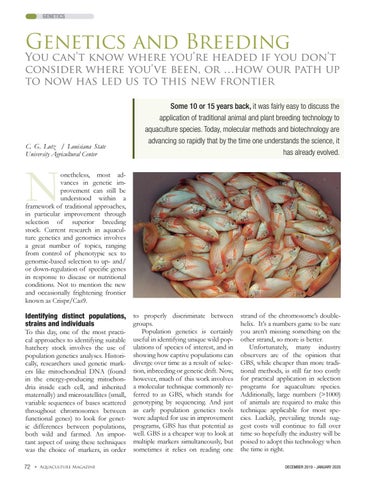GENETICS
Genetics and Breeding
You can’t know where you’re headed if you don’t consider where you’ve been, or …how our path up to now has led us to this new frontier
C. G. Lutz / Louisiana State University Agricultural Center
Some 10 or 15 years back, it was fairly easy to discuss the application of traditional animal and plant breeding technology to aquaculture species. Today, molecular methods and biotechnology are advancing so rapidly that by the time one understands the science, it has already evolved.
N
onetheless, most advances in genetic improvement can still be understood within a framework of traditional approaches, in particular improvement through selection of superior breeding stock. Current research in aquaculture genetics and genomics involves a great number of topics, ranging from control of phenotypic sex to genomic-based selection to up- and/ or down-regulation of specific genes in response to disease or nutritional conditions. Not to mention the new and occasionally frightening frontier known as Crispr/Cas9.
Identifying distinct populations, strains and individuals To this day, one of the most practical approaches to identifying suitable hatchery stock involves the use of population genetics analyses. Historically, researchers used genetic markers like mitochondrial DNA (found in the energy-producing mitochondria inside each cell, and inherited maternally) and microsatellites (small, variable sequences of bases scattered throughout chromosomes between functional genes) to look for genetic differences between populations, both wild and farmed. An important aspect of using these techniques was the choice of markers, in order 72 »
to properly discriminate between groups. Population genetics is certainly useful in identifying unique wild populations of species of interest, and in showing how captive populations can diverge over time as a result of selection, inbreeding or genetic drift. Now, however, much of this work involves a molecular technique commonly referred to as GBS, which stands for genotyping by sequencing. And just as early population genetics tools were adapted for use in improvement programs, GBS has that potential as well. GBS is a cheaper way to look at multiple markers simultaneously, but sometimes it relies on reading one
strand of the chromosome’s doublehelix. It’s a numbers game to be sure you aren’t missing something on the other strand, so more is better. Unfortunately, many industry observers are of the opinion that GBS, while cheaper than more traditional methods, is still far too costly for practical application in selection programs for aquaculture species. Additionally, large numbers (>1000) of animals are required to make this technique applicable for most species. Luckily, prevailing trends suggest costs will continue to fall over time so hopefully the industry will be poised to adopt this technology when the time is right. DECEMBER 2019 - JANUARY 2020
